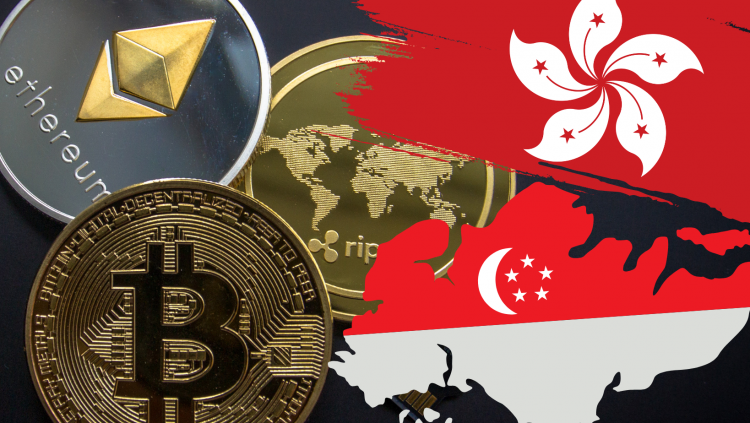Recently, both Hong Kong and Singapore released policy statements and pilot projects that show strong support for crypto innovation. This stirred up heated discussion about how these two financial hubs will compete with each other. However, what is really exciting is that these two hubs can complement each other, attract global resources and make Asia into a leading market for crypto adoption.
Hong Kong was one of the most important crypto trading hubs in the world until the regulatory environment turned restrictive in 2019. Back then, Hong Kong was the home of influential crypto exchanges like BitMEX and FTX. Many early adopters in the crypto community still have strong emotional ties to Hong Kong. That is why the Hong Kong government’s new enthusiasm toward crypto and Web 3.0 innovation was so widely celebrated as a sign that “Hong Kong is back.”
Singapore has benefited more than anywhere else from the exodus of Chinese crypto entrepreneurs, prompted by China’s crackdowns, over the past two years. The Token2049 conference in Singapore last month turned out to be one of the most well-attended global crypto and Web3 events in recent years despite the bear market that this industry is facing. In Token2049, we found that many Chinese teams that just relocated here are still actively building products. Meanwhile, deal makers, investors and industry leaders flew in from all over the world because they believed in the market potential of Asia. Singapore proved to be a place of convergence, even when “decoupling” is happening in other places.
The regulatory frameworks of Hong Kong and Singapore are still under development, and their detailed policies will continue to evolve. But with FTX’s unfolding drama, we can expect both Hong Kong and Singapore to tighten regulation on speculative trading, though some differences are already emerging between the two governments’ approaches.
Singapore has stringent measures that limit retail investors’ exposure to digital assets. While such measures aim to protect retail investors from speculative activities, they also could create the problem of unequal access, which puts retail investors at a disadvantage compared to accredited and institutional investors.
Hong Kong, on the other hand, will likely be more open to retail investment activities. In its statement, its Financial Services and the Treasury Bureau said that they would conduct a public consultation about retail access, in particular, opening up the possibility of having exchange-traded funds (ETFs) of digital assets.
The good thing is, entrepreneurs and investors in the crypto and Web3 space do not have to make a choice between Singapore and Hong Kong. The flow of capital and people — especially with the recent easing of Hong Kong’s Covid-19 travel restrictions — is easy enough for organizations to operate in both places and make the best of each’s advantages. The competition between Hong Kong and Singapore also means that they will stimulate each other into taking bolder and faster steps.
In the global market, the United States has an unparalleled ecosystem of venture capital, technology startups and a deep capital market. It will continue to shape the fundamental technologies, narratives and even regulations of the crypto and Web3 world.
But Singapore and Hong Kong have something different to offer. For blockchain technology to truly become the next-generation financial infrastructure, smart contracts running on blockchains need to interact with real-world assets. This cannot happen without the coordination of a complicated set of stakeholders on-chain and off-chain, from protocol builders to government branches, banks and security exchanges.
In the U.S., this kind of coordination is often hindered by highly ideological political debates. Regulatory clarity is still missing because of the ongoing disagreements over issues like whether publishing smart contracts is free speech, whether decentralized finance protocols have the same compliance obligation as traditional financial service providers, or which tokens are security and which are commodities.
This is where the pragmatic approach of Hong Kong and Singapore can make a difference. While keeping the bottom line of fending off money laundering, terrorism financing and technology risks, the governments of Hong Kong and Singapore are efficient in bringing the public and private sectors together to explore new use cases for crypto technology.
Singapore just launched an industry pilot for institutional DeFi. The Monetary Authority of Singapore (MAS) has brought together institutions like DBS Bank, JPMorgan and SBI Digital Asset Holdings to experiment with DeFi application on a public blockchain, involving foreign exchange with tokenized JPY and SGD and transactions with tokenized government bonds. Hong Kong also launched a pilot project of green bond tokenization.
What Singapore and Hong Kong are doing appears to be quite top-down and centralized, contradicting the permissionless principle of the crypto movement. However, by tokenizing real-world assets, they are giving institutions and people reasons to use digital assets and are effectively accelerating the mainstream adoption of crypto technology. With more mainstream adoption, grassroots startups will also have a bigger market for their bottom-up innovations.
There is another important resource that Singapore and Hong Kong can draw upon — the tech entrepreneurs and talents from mainland China. In the Web 2.0 era, Chinese internet companies were able to create products that are in the same league as the leading U.S. companies in terms of scale and innovative features. A lot of their know-how will continue to be relevant in the crypto and Web 3.0 economy.
In fact, Chinese Web2 giants that are listed on the Hong Kong stock exchange, such as Tencent, Alibaba, Bilibili and Baidu, have been testing their business or investment in crypto technology in different forms, but they did not have a market to do bold experiments in. Now Hong Kong might be exactly the hotbed they need.
Some people might doubt that Hong Kong can have policies toward crypto and Web3 that are fundamentally different from those of the mainland. But as China is facing a real threat of isolation because of geopolitics and the Covid pandemic, it needs Hong Kong more than ever as a hub that connects with the world and stays at the frontier of global finance.
Meanwhile, Singapore is also attracting many technology companies from China that are using it as a gateway to the global market.
If we look at the Asia market at large, there are still a big population who do not have access to convenient financial services or solid investment opportunities. Both Hong Kong and Singapore’s financial institutions have extensive influence in this region, they are in good positions to enhance financial inclusion in this region by leveraging crypto technology.
The last bull cycle of crypto assets was unfortunately very much driven by speculation, and the rise and fall of FTX, Three Arrows Capital and Terra-LUNA remind us that speculation and empty narratives cannot give crypto technology a real future.
The next bull cycle will only come when the crypto industry finds ways to solve real-world problems and achieve mass adoption. Asia is the perfect market for crypto entrepreneurs to innovate with not only on-chain tokens but also real-world assets, not only for investors but also for mass users. Hong Kong and Singapore are not competing for a fixed pie, they both have important roles to play in the next growth cycle of Asia’s digital economy.
Source by forkast.news





















